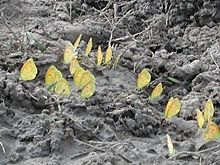Eurema nicippe
| Eurema nicippe | ||||||||||||
|---|---|---|---|---|---|---|---|---|---|---|---|---|

Eurema nicippe |
||||||||||||
| Systematics | ||||||||||||
|
||||||||||||
| Scientific name | ||||||||||||
| Eurema nicippe | ||||||||||||
| ( Cramer , 1779) |
Eurema nicippe is occurring in North and Central America butterfly ( butterfly ) from the family of Whites (Pieridae).
features
butterfly
The moths reach a wingspan of 35 to 57 millimeters. There is no sexual dimorphism between the sexes . The basic color of all wing tops is yellow to yellow-orange. From the middle of the anterior margin and the apex of the forewings, a broad black-brown band runs along the seam, which continues strongly on the hind wings. A narrow, elongated black discal spot clearly stands out. The undersides of the wings are almost without drawings, only a few very small brownish or reddish spots are sometimes present. In the summer season they are yellow, while in the winter season they are colored ocher to light reddish brown.
Egg, caterpillar, pupa
The eggs have the shape of an elongated ellipsoid of revolution and a whitish to yellowish color. Young caterpillars are colored green and show many small white spots and a white stripe on the side. When fully grown, they are also colored green and have a yellow-white side stripe. The entire surface of the body is covered with very short, light hairs. The doll is designed as a belt doll and initially has a green color, from which a whitish side line and very small black dots stand out. The head is pointed, the wing sheaths protrude. Shortly before hatching, the wing pattern already shines through the wing sheaths.
distribution and habitat
The range of occurrence of the species extends from California , Texas and Florida south to Central America including the Greater Antilles . Individual specimens that migrated north have been found in Wyoming and Ontario .
Eurema nicippe primarily inhabits open field landscapes, dry shrubbery zones, wasteland, gardens and roadsides.
Way of life
The moths fly in several successive generations throughout the year. The late summer generation overwinters as moths in most of the occurrence areas. Both sexes like to suckle on flowers for food intake, for example on hairy two-toothed teeth ( Bidens pilosus ) or species of lantana ( lantana ). Sometimes they go to large numbers of humid places in the earth to take in fluids and minerals. The females lay the eggs individually on the underside of leaves or on the flower buds of the food plants. The caterpillars live individually and feed on the leaves of various legumes (Fabaceae), including cassia ( Cassia ) and clover ( Trifolium ). The moths sometimes have a very leisurely flight style (sleepy), which is why they are referred to as Sleepy Orange in English .
Individual evidence
- ↑ Sleepy Orange at Butterflies and Moths of North America
- ↑ a b Markku Savela: Tanaecia Butler, (1869) - distribution. In: Lepidoptera and some other life forms. Retrieved January 24, 2019 .
- ^ A b James A. Scott: The butterflies of North America. Stanford University Press, Stanford, California 1986, ISBN 0-8047-1205-0 , p. 206
literature
James A. Scott: The butterflies of North America. Stanford University Press, Stanford, California 1986, ISBN 0-8047-1205-0 , p. 206
Web links
- butterfliesofamerica - Egg, caterpillar and pupa at Butterflies of America
- bugguide - Iowa State University's BugGuide
- learnaboutbutterflies - Sleepy Orange
- insecta.pro - Taxonomy at Insecta.pro



